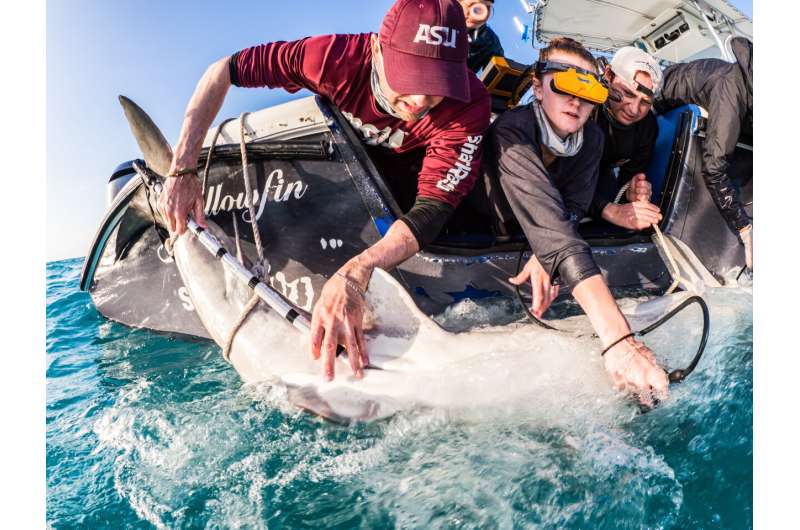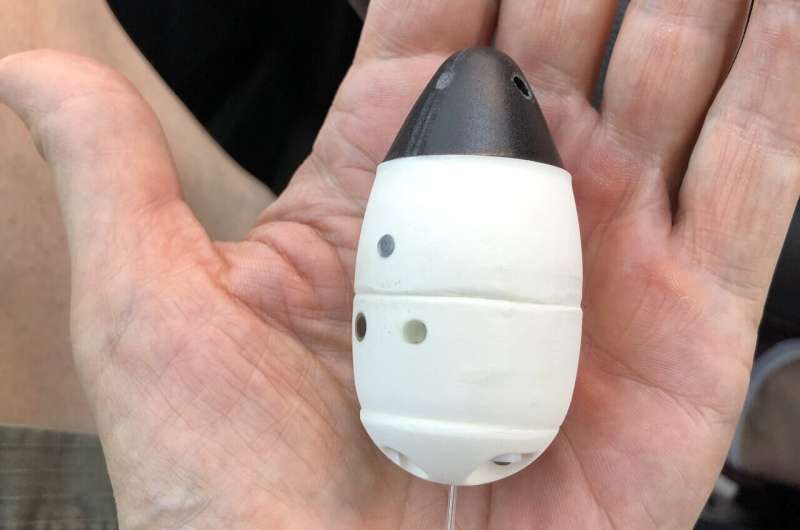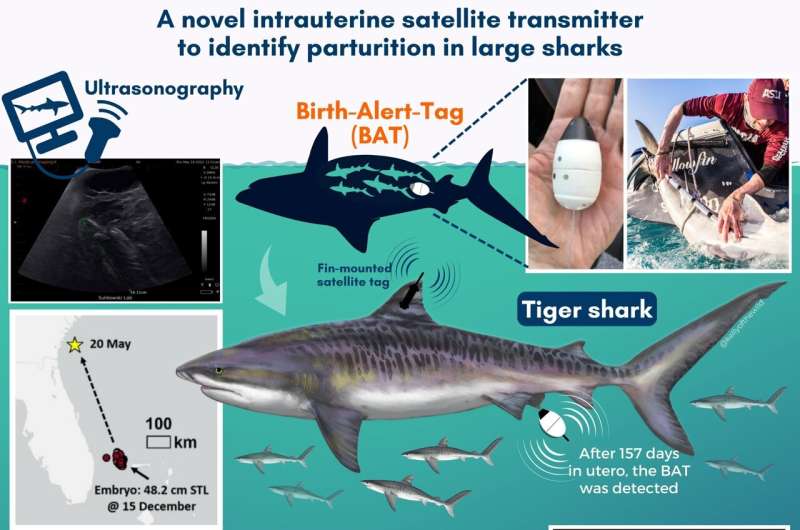This article has been reviewed according to Science X's editorial process and policies. Editors have highlighted the following attributes while ensuring the content's credibility:
fact-checked
peer-reviewed publication
trusted source
proofread
Pregnant shark birth tracking technology provides key data for species protection

Most people find sharks threatening. Who doesn't have an image in their mind of a menacing shark fin racing through the ocean in search of its next meal?
But it is the shark that is threatened.
According to Defenders of Wildlife, a national nonprofit dedicated to protecting imperiled species, 75% of shark species are threatened with extinction and up to 73 million sharks are being killed each year for their fins.
Habitats that were once secure places for sharks to give birth have also been affected. And the fact that sharks have long gestation periods, giving birth to relatively few young, and maturing late in life—complicates efforts at repopulation. And that's a problem.
In a new paper published today (March 1) in Science Advances, authors James Sulikowski, a professor at Arizona State University and Neil Hammerschlag, a marine ecologist at the University of Miami, describe a new technology they developed capable of remotely documenting the location and time of birth of shark pups. This type of data will enable scientists to create ways to protect the sharks' most vulnerable habitats, where they give birth.
"If they (the mother sharks) don't have that suitable habitat, then their babies won't be able to grow up. And if babies don't grow up, we have no more sharks and literally, the ocean ecosystem would collapse," explained James Sulikowski, senior Global Futures scientist at Arizona State University and director of the Sulikowski Shark and Fish Conservation Lab at ASU's New College of Interdisciplinary Arts and Sciences.

The device is making waves in the scientific community—and for good reason.
"We've been trying to do this since we started studying sharks. This is our holy grail. We have really advanced shark science, 20, 30, 40 years," said Sulikowski. "This novel, satellite-based technology will be especially valuable for the protection of threatened and endangered shark species, where protection of pupping and nursery grounds is a conservation priority."
The paper outlines the deployment and results of an intrauterine satellite tag on two highly mobile sharks—a scalloped hammerhead and a tiger shark—to detect when birth occurs, leading to its name, birth-alert-tags (BAT).
Here's how BAT works.
First the BAT is inserted into a pregnant shark. The egg-shaped technology is approximately 2 inches long and 1 inch wide. When the shark gives birth, the BAT pops out along with the pups and reaches the ocean surface. Once there, the device switches to transmitter mode sending messages announcing the time and location of the birth.
The BAT has already yielded remarkable results. Where it was once assumed that sand sharks gave birth inland, the scientists have learned that they are most comfortable having their pups in abandoned shipwrecks on the ocean floor.
"It was a total surprise," Sulikowski said. "For most shark species we have no idea where they give birth or how far they must travel to habitats that are essential to their survival."
Once habitats are discovered, efforts will be made to protect those areas, either by creating sanctuaries or expanding areas already set aside for this purpose.
The ultimate goal is to go global with the BAT.
Sulikowski wants to create a worldwide network of shark scientists to determine areas that are important to sharks and figure out how to protect them.

Persistence pays off
Sulikowski is enjoying his current success. "We've had every sort of failure that can happen," he said. "We had battery failures. We had firmware failures, we had antenna failures. I felt like giving up multiple times. But thanks to my co-author, Neil Hammerschlag, we kept forging ahead and we didn't give up."
"Honestly, it feels incredible to have created technology that is going to revolutionize the way that we study sharks," Sulikowski added.
More information: James Sulikowski et al, A novel intrauterine satellite transmitter to identify parturition in large sharks, Science Advances (2023). DOI: 10.1126/sciadv.add6340. www.science.org/doi/10.1126/sciadv.add6340
Journal information: Science Advances
Provided by Arizona State University





















